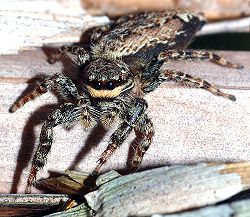- Dionycha
-
Dionycha 
Marpissa muscosa Scientific classification Kingdom: Animalia Phylum: Arthropoda Class: Arachnida Order: Araneae Suborder: Araneomorphae Infraorder: Entelegynae Section: Dionycha Families See text.
Diversity 17 families The Dionycha are a phylogenetic group of spiders (Araneomorphae:Entelegynae) with about 10,000 species. 17 families belong to this group, amongst others: Salticidae (jumping spiders), Gnaphosoidea, Thomisidae (crab spiders), and the Clubionidae. Spiders in this group have better senses (sight, hearing) than others, some even show courtship dances and songs.
The Dionycha probably evolved from the web-building Trionycha. Unlike these, the Dionycha have only two instead of three tarsal claws. The central third claw of the Trionycha is responsible for tracking the silk thread. Instead of this claw, Dionycha have dense tufts of scupula hairs that produce strong adhesion, enabling some species to climb glass. Most species hunt their prey instead of building webs, although some species of Trionycha (members of Lycosoidea) also hunt.
There are no cribellate members in the Dionycha[1].
The monophyly of the Dionycha has been disputed. Today it is thought that the reduction of the third claw evolved several times independently.
Contents
Cladogram (after Coddington & Levi, 1991, simplified)
Araneomorphae Entelegynae Trionycha
Dionycha Corinnidae
Liocranidae
Gnaphosoidea (7 families, c. 3,000 species)
Clubionidae
Anyphaenidae
Salticidae, > 5,000 species
Thomisidae, > 2,000 species
Sparassidae
Selenopidae
Footnotes
- ^ Griswold et al. 1999
References
- J. Bosselaers and R. Jocqué. 2002. Studies in Corinnidae: cladistic analysis of 38 corinnid and liocranid genera, and transfer of Phrurolithinae. Zoologica Scripta 31:241-270.
- J. A. Coddington and H. W. Levi. 1991. Systematics and evolution of spiders (Araneae). Annual Review of Ecology and Systematics 22:565-592.
- Griswold, C.E., Coddington, J.A., Platnick, N.I. and Forster, R.R. (1999). Towards a Phylogeny of Entelegyne Spiders (Araneae, Araneomorphae, Entelegynae). Journal of Arachnology 27:53-63. PDF
External links
Categories:
Wikimedia Foundation. 2010.
